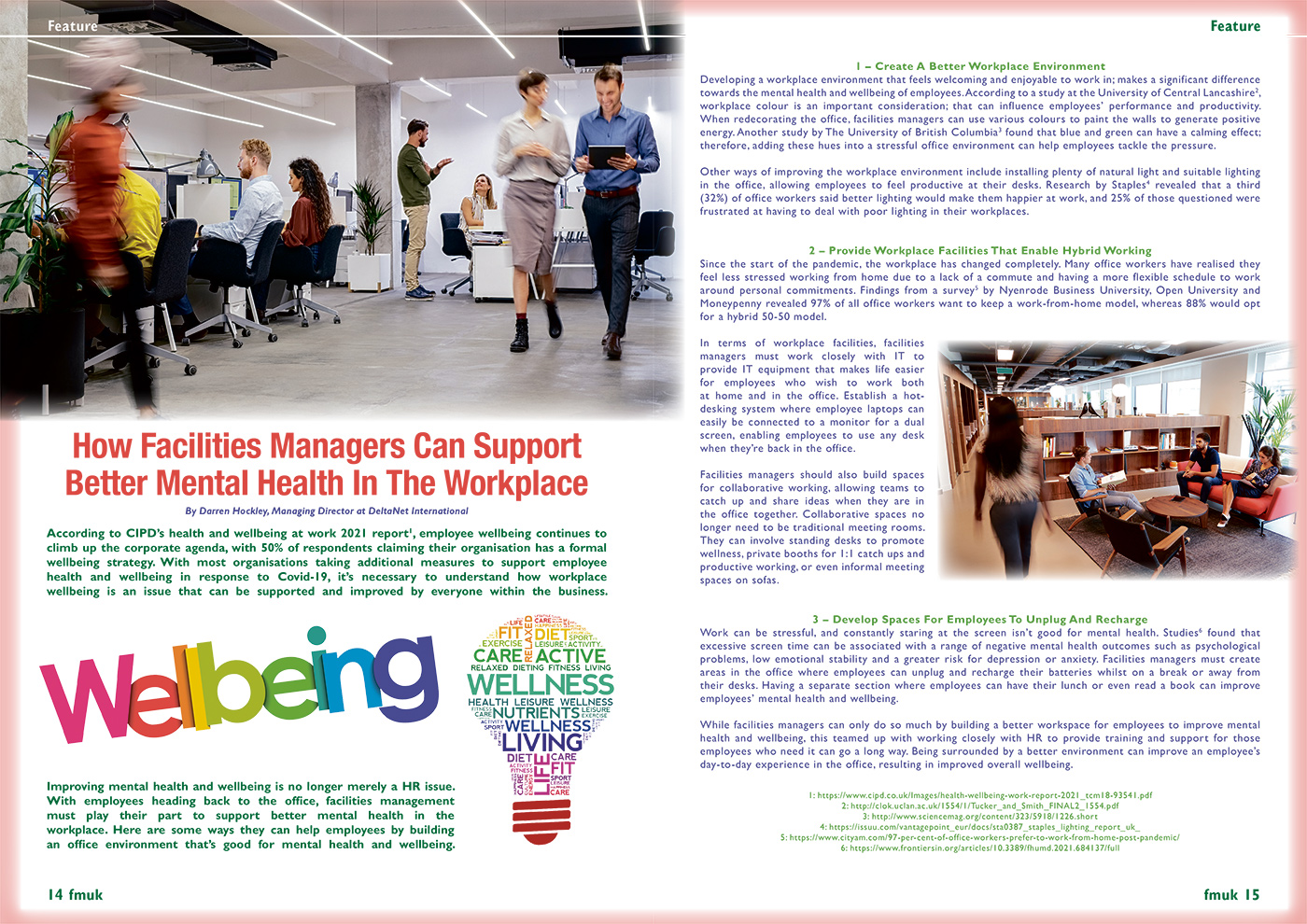How Facilities Managers Can Support Better Mental Health In The Workplace
 By Darren Hockley, Managing Director at DeltaNet International
By Darren Hockley, Managing Director at DeltaNet International
According to CIPD’s health and wellbeing at work 2021 report, employee wellbeing continues to climb up the corporate agenda, with 50% of respondents claiming their organisation has a formal wellbeing strategy. With most organisations taking additional measures to support employee health and wellbeing in response to Covid-19, it’s necessary to understand how workplace wellbeing is an issue that can be supported and improved by everyone within the business.
Improving mental health and wellbeing is no longer merely a HR issue. With employees heading back to the office, facilities management must play their part to support better mental health in the workplace. Here are some ways they can help employees by building an office environment that’s good for mental health and wellbeing.
1 – Create A Better Workplace Environment
Developing a workplace environment that feels welcoming and enjoyable to work in; makes a significant difference towards the mental health and wellbeing of employees. According to a study at the University of Central Lancashire, workplace colour is an important consideration; that can influence employees’ performance and productivity. When redecorating the office, facilities managers can use various colours to paint the walls to generate positive energy. Another study by The University of British Columbia found that blue and green can have a calming effect; therefore, adding these hues into a stressful office environment can help employees tackle the pressure.
Other ways of improving the workplace environment include installing plenty of natural light and suitable lighting in the office, allowing employees to feel productive at their desks. Research by Staples revealed that a third (32%) of office workers said better lighting would make them happier at work, and 25% of those questioned were frustrated at having to deal with poor lighting in their workplaces.
2 – Provide Workplace Facilities That Enable Hybrid Working
Since the start of the pandemic, the workplace has changed completely. Many office workers have realised they feel less stressed working from home due to a lack of a commute and having a more flexible schedule to work around personal commitments. Findings from a survey by Nyenrode Business University, Open University and Moneypenny revealed 97% of all office workers want to keep a work-from-home model, whereas 88% would opt for a hybrid 50-50 model.
In terms of workplace facilities, facilities managers must work closely with IT to provide IT equipment that makes life easier for employees who wish to work both at home and in the office. Establish a hot-desking system where employee laptops can easily be connected to a monitor for a dual screen, enabling employees to use any desk when they’re back in the office.
Facilities managers should also build spaces for collaborative working, allowing teams to catch up and share ideas when they are in the office together. Collaborative spaces no longer need to be traditional meeting rooms. They can involve standing desks to promote wellness, private booths for 1:1 catch ups and productive working, or even informal meeting spaces on sofas.
3 – Develop Spaces For Employees To Unplug And Recharge
Work can be stressful, and constantly staring at the screen isn’t good for mental health. Studies found that excessive screen time can be associated with a range of negative mental health outcomes such as psychological problems, low emotional stability and a greater risk for depression or anxiety. Facilities managers must create areas in the office where employees can unplug and recharge their batteries whilst on a break or away from their desks. Having a separate section where employees can have their lunch or even read a book can improve employees’ mental health and wellbeing.
While facilities managers can only do so much by building a better workspace for employees to improve mental health and wellbeing, this teamed up with working closely with HR to provide training and support for those employees who need it can go a long way. Being surrounded by a better environment can improve an employee’s day-to-day experience in the office, resulting in improved overall wellbeing.
Click the article to enlarge it.























































